
Bermuda is an overseas territory of the United Kingdom in the North Atlantic Ocean. Located off the east coast of the United States, it is situated around 1,770 km (1,100 mi) northeast of Miami, Florida, and 1,350 km (840 mi) south of Halifax, Nova Scotia, west of Portugal, northwest of Brazil, 1,759 km (1,093 mi) north of Havana, Cuba and north-northeast of San Juan, Puerto Rico. The nearest landmass is Cape Hatteras, North Carolina, about 1,030 km (640 mi) west-northwest, followed by Cape Sable Island, Nova Scotia, Canada 1,236 km northward. Although commonly referred to in the singular, the territory consists of approximately 138 islands, with a total area of 57 km2 (22 sq mi).

Andros Island is an archipelago within The Bahamas, the largest of the Bahamian Islands. Politically considered a single island, Andros in total has an area greater than all the other 700 Bahamian islands combined. The land area of Andros consists of hundreds of small islets and cays connected by mangrove estuaries and tidal swamplands, together with three major islands: North Andros, Mangrove Cay, and South Andros. The three main islands are separated by bights, estuaries that trifurcate the island from east to west. It is 167 kilometres (104 mi) long by 64 km (40 mi) wide at the widest point.

The City of Hamilton, in Pembroke Parish, is the territorial capital of the British Overseas Territory of Bermuda. It is the territory's financial centre and a port and tourist destination. Its population of 854 (2016) is one of the smallest of any capital city.

St. George's, located on the island and within the parish of the same names, settled in 1612, is the first permanent English settlement on the islands of Bermuda. It is often described as the third permanent British settlement in the Americas, after Jamestown, Virginia (1607), and Cupids, Newfoundland (1610), and the oldest continuously-inhabited British town in the New World, since the other two settlements were seasonal for a number of years.
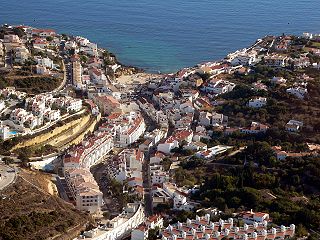
Carvoeiro is a town and a former civil parish in the municipality (concelho) of Lagoa, Algarve, Portugal. In 2013, the parish merged into the new parish Lagoa e Carvoeiro. The population in 2011 was 2,721, in an area of 11.66 km². It is located about 5 kilometres (3.1 mi) south of Lagoa.
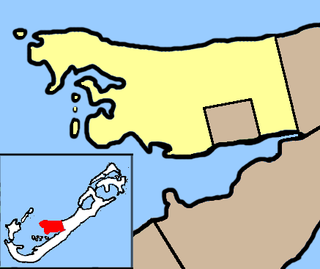
Pembroke Parish is one of the nine parishes of Bermuda. It is named after English aristocrat William Herbert, 3rd Earl of Pembroke (1580–1630).

Smith's Parish is one of the nine parishes of Bermuda. It is named for English aristocrat Sir Thomas Smith or Smythe (1558–1625).

Hamilton Parish is one of the nine parishes of Bermuda. It was renamed for Scottish aristocrat James Hamilton, 2nd Marquess of Hamilton (1589–1625) when he purchased the shares originally held in the Virginia Company by Lucy Russell, Countess of Bedford.
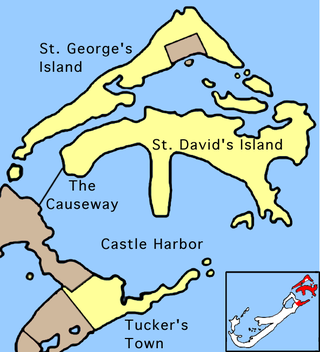
St. George's Parish is one of the nine parishes of Bermuda. It is named after the founder of the Bermuda colony, Admiral Sir George Somers.

Hamilton Harbour is a natural harbour in Bermuda which serves as the port for the capital, the City of Hamilton. It is an arm of the Great Sound, and forms a tapering wedge shape of water between Paget Parish and the peninsula which forms Pembroke Parish, and upon which the capital sits.
Devil's Hole was a large water-filled sinkhole, close to the southeastern corner of Harrington Sound, Bermuda. At one time an littoral cave, it is fed by the Atlantic Ocean proper, rather than the far closer sound, via an underground estuary. It closed in 2009.
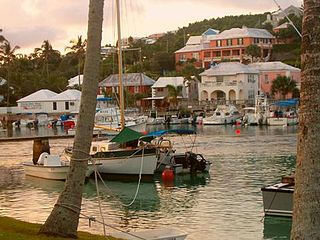
Flatt's Inlet is a small channel in Bermuda which joins Harrington Sound with the Atlantic Ocean. It lies almost exactly between the territory's two municipalities, Hamilton and St. George's.
Mangrove Lake is Bermuda's largest lake. Like many of Bermuda's other lakes, it is brackish, as it lies close to the Atlantic Ocean and can be inundated by it in storms.
Trott's Pond is a small lake in the northeast of Bermuda that is created by the sinkhole. Like many of Bermuda's lakes, it water is Brackish water, as it lies close to the Atlantic Ocean.
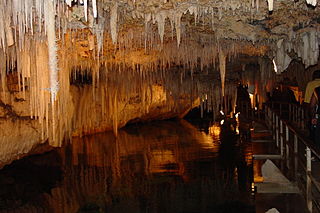
Crystal Cave is a cave in the British overseas territory of Bermuda. It is located in Hamilton Parish, close to Castle Harbour. The cave is approximately 500 m long, and 62 m deep. The lower 19–20 m of the cave are below water level. The cave formed at a time when the sea level was lower; as the sea level rose, many cave formations which formed above water became submerged.

Castle Harbour is a large natural harbour in Bermuda. It is located between the northeastern end of the main island and St. David's Island. Originally called Southampton Port, it was renamed as a result of its heavy fortification in the early decades of the Seventeenth century.
The following is a list of places of interest in Bermuda.
Henry Jennings was an English privateer-turned-pirate. Jennings's first recorded act of piracy took place in early 1716 when, with three vessels and 150–300 men, Jennings's fleet ambushed the Spanish salvage camp from the 1715 Treasure Fleet. After the Florida raid, Jennings and his crew also linked up with Benjamin Hornigold's "three sets of pirates" from New Providence Island.

The following is an alphabetical list of topics related to the British Overseas Territory of the Bermuda Islands.















